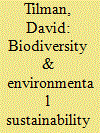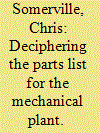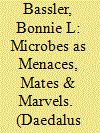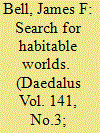|
|
|
Sort Order |
|
|
|
Items / Page
|
|
|
|
|
|
|
| Srl | Item |
| 1 |
ID:
116825


|
|
|
|
|
| Publication |
2012.
|
| Summary/Abstract |
Concern about the loss of Earth's biological diversity sparked two decades of research of unprecedented intensity, intellectual excitement, and societal relevance. This research shows that biodiversity is among the most important factors determining how ecosystems function. In particular, the loss of biodiversity decreases the productivity, stability, and efficiency of terrestrial, freshwater, and marine ecosystems. These research findings come at a time of rapidly increasing threats to global biodiversity resulting from agricultural land clearing, climate change, and pollution caused by globally accelerating demand for food and energy. The world faces the grand, multifaceted challenge of meeting global demand for food and energy while preserving Earth's biodiversity and the long-term sustainability of both global societies and the ecosystems upon which all life depends. The solutions to this challenge will require major advances in, and syntheses among, the environmental and social sciences.
|
|
|
|
|
|
|
|
|
|
|
|
|
|
|
|
| 2 |
ID:
116818


|
|
|
|
|
| Publication |
2012.
|
| Summary/Abstract |
Energy demand in the twenty-first century will be driven by the needs of three billion people in the emerging world and three billion new inhabitants to our planet. To provide them with a renewable and sustainable energy supply is perhaps the greatest challenge for science in the twenty-first century. The science practiced to meet the energy needs of the twentieth century responded to a society of wealth, and energy systems were designed to be large and centralized. However, the inability of the emerging world to incur large capital costs suggests that a new science must be undertaken, one that does not rely on economy of scale but rather sets as its target highly manufacturable and distributed energy systems that are affordable to the poor. Only in this way can science provide global society with its most direct solution for a sustainable and carbon-neutral energy future.
|
|
|
|
|
|
|
|
|
|
|
|
|
|
|
|
| 3 |
ID:
116824


|
|
|
|
|
| Publication |
2012.
|
| Summary/Abstract |
The Earth's population is aging fast, and the coming sharp increase in the number of people over age sixty-five will bring with it an epidemic of age-related neurodegenerative diseases, such as Alzheimer's and Parkinson's diseases. Currently, no cures exist for the major neurologic disorders. Unless cures can be found, by 2050 the cost of these diseases will exceed $1 trillion annually in the United States, and the burden for other countries will scale with their populations. Despite exciting advances in our understanding of these diseases, both government research funding and the efforts of industry have failed to keep pace with this unmet medical need. Private philanthropy has done better, but the total dollars spent on developing diagnostics and therapeutics for neurologic disorders still lags far behind that spent on much less prevalent diseases. The challenge for biomedical research in the next forty years is to identify markers that would allow early detection of high-risk cohorts, and to develop therapies that either will prevent the diseases from starting at all in susceptible populations or will arrest their progression before severe damage to the central nervous system has occurred.
|
|
|
|
|
|
|
|
|
|
|
|
|
|
|
|
| 4 |
ID:
116822


|
|
|
|
|
| Publication |
2012.
|
| Summary/Abstract |
The development of inexpensive DNA sequencing technologies has revolutionized all aspects of biological research. The proliferation of plant genome sequences, in conjunction with the parallel development of robust tools for directed genetic manipulation, has given momentum and credibility to the goal of understanding several model plants as the sum of their parts. A broad inventory of the functions and interrelationships of the parts is currently under way, and the first steps toward computer models of processes have emerged. These approaches also provide a framework for the mechanistic basis of plant diversity. It is hoped that rapid progress in this endeavor will facilitate timely responses to expanding demand for food, feed, fiber, fuel, and ecosystem services in a period of climate change.
|
|
|
|
|
|
|
|
|
|
|
|
|
|
|
|
| 5 |
ID:
116816


|
|
|
|
|
| Publication |
2012.
|
| Summary/Abstract |
In this brief survey, I discuss some examples of the fascinating phenomenon of universality in complex systems, in which universal macroscopic laws of nature emerge from a variety of different microscopic dynamics. This phenomenon is widely observed empirically, but the rigorous mathematical foundation for universality is not yet satisfactory in all cases.
|
|
|
|
|
|
|
|
|
|
|
|
|
|
|
|
| 6 |
ID:
116821


|
|
|
|
|
| Publication |
2012.
|
| Summary/Abstract |
History is omnipresent in the natural world, from inside rocks on the continents to the genes, cells, and organs of each creature on the planet. Linking the historical records of rocks, fossils, and genes has been a boon to understanding the major events in evolution. We use these seemingly different lines of evidence as tools for discovery: analyses of genes can predict likely places to find fossils, and new fossils can provide the means to interpret insights from genetics. Viewed in this way, every living thing on Earth is the extreme tip of a deeply branched tree of life that extends three billion years into the past. Genes and fossils reveal how deeply connected our species is to the rest of the living world and the planet itself.
|
|
|
|
|
|
|
|
|
|
|
|
|
|
|
|
| 7 |
ID:
116819


|
|
|
|
|
| Publication |
2012.
|
| Summary/Abstract |
Fundamental physics began the twentieth century with the twin revolutions of relativity and quantum mechanics, and much of the second half of the century was devoted to the construction of a theoretical structure unifying these radical ideas. But this foundation has also led us to a number of paradoxes in our understanding of nature. Attempts to make sense of quantum mechanics and gravity at the smallest distance scales lead inexorably to the conclusion that space-time is an approximate notion that must emerge from more primitive building blocks. Furthermore, violent short-distance quantum fluctuations in the vacuum seem to make the existence of a macroscopic world wildly implausible, and yet we live comfortably in a huge universe. What, if anything, tames these fluctuations? Why is there a macroscopic universe? These are two of the central theoretical challenges of fundamental physics in the twenty-first century. In this essay, I describe the circle of ideas surrounding these questions, as well as some of the theoretical and experimental fronts on which they are being attacked.
|
|
|
|
|
|
|
|
|
|
|
|
|
|
|
|
| 8 |
ID:
116820


|
|
|
|
|
| Publication |
2012.
|
| Summary/Abstract |
The conventional understanding of microbes as causative agents of disease has led us to fear them and to consider them our deadly enemies. Much less appreciated are the central roles microbes play in shaping the environment and in maintaining plant, animal, and human health. All metazoan organisms - organisms that we can see with the naked eye - exist in lifelong partnerships with vast microbial communities. These "microbiomes" supply metazoans with essential life processes that are not encoded in nonmicrobial genomes. Recent work in microbiology has revealed that microbes, like metazoans, have specific body plans and sensory systems, that they can communicate with each other, and that they orchestrate collective behaviors. Investigations of these ancient yet enduring processes are uncovering the fundamental design principles of life. Microbes are also storehouses of new molecules, biochemical pathways, and materials with medical, industrial, and agricultural relevance. Scientists are harnessing these microbial products in efforts to confront humanity's most pressing problems. This essay explores the wonder, complexity, power, and utility of microbes in the twenty-first century.
|
|
|
|
|
|
|
|
|
|
|
|
|
|
|
|
| 9 |
ID:
116814


|
|
|
| 10 |
ID:
116815


|
|
|
|
|
| Publication |
2012.
|
| Summary/Abstract |
The search for and detailed characterization of habitable environments on other worlds - places where liquid water, heat/energy sources, and biologically important organic molecules exist or could have once existed - is a major twenty-first-century goal for space exploration by NASA and other space agencies, motivated by intense public interest and highly ranked science objectives identified in recent National Academy decadal surveys. Through telescopic observations, terrestrial laboratory and field studies, and a "flyby, orbit, land, rove, and return" strategy for robotic exploration, particular emphasis will be placed on specific worlds already identified as potentially habitable: Mars, Jupiter's ocean moon Europa, and Saturn's icy and organic-bearing moons Titan and Enceladus. However, the potential abounds for surprising discoveries at many of our solar system's other planetary, satellite, and asteroidal destinations, as well as within newly discovered planetary systems around other stars.
|
|
|
|
|
|
|
|
|
|
|
|
|
|
|
|
| 11 |
ID:
116817


|
|
|
|
|
| Publication |
2012.
|
| Summary/Abstract |
Over the last fifty years, small has emerged as the new big thing. The reduction of information and electronics to nanometer dimensions has revolutionized science, technology, and society. Now scientists and engineers are creating physical machines that operate at the nanoscale. Using approaches ranging from lithographic patterning to the co-opting of biological machinery, new devices are being built that can navigate, sense, and alter the nanoscale world. In the coming decades, these machines will have enormous impact infields ranging from biotechnology to quantum physics, blurring the boundary between technology and life.
|
|
|
|
|
|
|
|
|
|
|
|
|
|
|
|
|
|
|
|
|